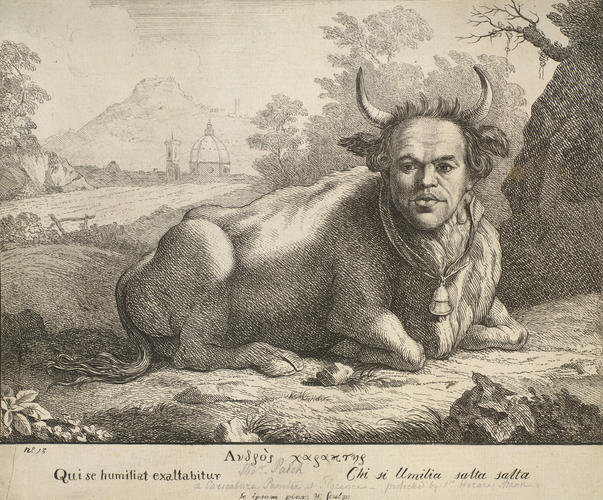Thomas Patch (c. 1725-82)
A self-portrait as an ox c. 1768-70
Etching | 28.2 x 34.1 cm (sheet of paper) | RCIN 811275
-
A self-portrait of Thomas Patch as an ox, sitting in a meadow on the outskirts of Florence. He has a bell on a ribbon around his neck. Inscribed below: N.o 13 / Αυδρός Χαραχτης / Qui se humiliate exaltabitur / Chi si Umilia salta salta / Se ipsum pinx: & sculp:; and in pencil in a contemporary hand, Tho.s Patch / a Caricatura Painter at Florence – protected by Sir Horace Mann. The sheet has been trimmed within the platemark.
Thomas Patch was born in Exeter, the son of a surgeon, and was expected to follow his father’s profession. He soon abandoned his medical studies and travelled to Rome where he trained as a painter, producing classical views for the tourist market. In 1755 he was expelled from Rome for homosexuality and settled in Florence, where he remained for the rest of his life. There he continued to paint landscapes but also developed an interest in physiognomy, the supposed science of determining character through the form of one’s face and body. He apparently conducted sustained research towards a treatise, Le regole del fisonomizare (‘The rules of physiognomy’), which a self-caricature painting of 1774 shows him holding but which survives only in fragmentary form.
Among the disjecta membra of Patch’s project are two series of caricature prints, 25 full-length figures and 28 heads made between 1765 and 1770. Of the full-length series, most depict residents of Florence and milordi on the Grand Tour but two are self-portraits – one showing Patch seated, measuring an Antique mask with a pair of dividers, and the present remarkable image, which shows his head grafted onto an ox’s body, seated in a landscape with the cathedral of Florence in the distance.
James Hall relates this image to an anecdote in Giorgio Vasari’s biography of Michelangelo (1568): ‘A certain painter, I know not who, had executed a work wherein was an ox, which looked better than any other part; and Michelangelo, being asked why the painter had made the ox more lifelike than the rest, said: “Any painter can make a good portrait of himself” (Hall 2014, p. 107). Michelangelo’s quip referred to the well-established idea that ‘every painter paints himself’ (‘ogni pittore dipinge se’) and was no more than a dig at the bovine character of the unnamed painter. But Patch embraces this and, with false humility, turns it on its head: the inscriptions in Latin and garbled Italian are partial quotations from the Gospel of St Luke (14: 11 and 18: 14), ‘he that humbleth himself shall be exalted’. The Greek inscription may be translated as ‘Engraver of Man’, but with a pun on the word ‘character’: Patch thus presents himself almost as a labelled scientific specimen: the engraver of human physiognomy who, by humbling himself through such apparently menial work, will yet attain glory.
Text adapted from Portrait of the Artist, London, 2016 -
Creator(s)
-
Medium and techniques
Etching
Measurements
28.2 x 34.1 cm (sheet of paper)
Category
Object type(s)
Alternative title(s)
(Greek characters) Qui se humiliat exaltabitur. Chi si umilia salta salta.









